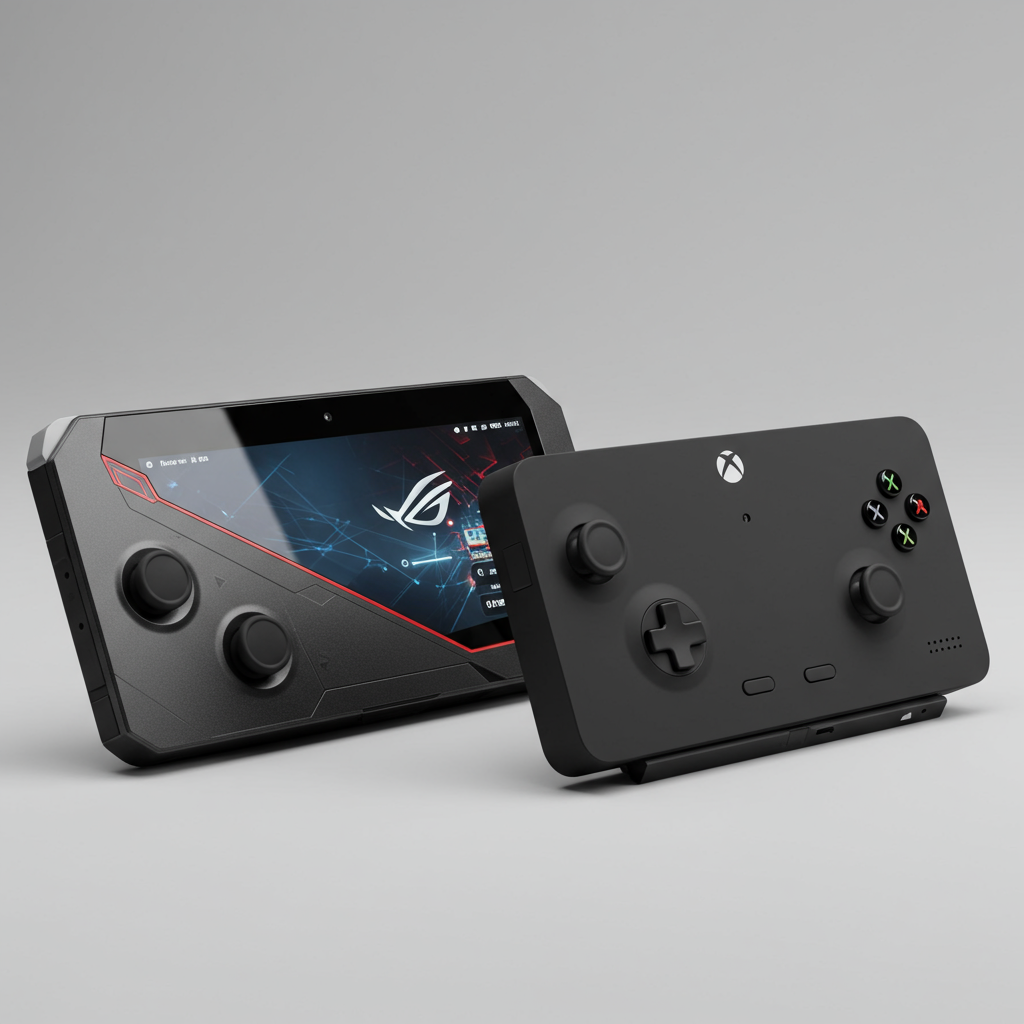Handheld gaming PCs are rapidly evolving, offering players powerful experiences on the go. Among the most popular are Asus’s ROG Ally models. Microsoft and Asus recently unveiled new “Xbox handhelds,” which are essentially fresh takes on the familiar ROG Ally design.
This introduces a key question for potential buyers: Should you stick with the proven Asus ROG Ally or opt for the new Xbox-branded version? Does “bigger” (specifically, a bigger battery and focus on comfort) truly make the new ROG Xbox Ally better? Let’s break down the core differences to help you decide which handheld deserves a spot in your backpack.
The Evolving ROG Ally Lineup
The handheld PC market is more vibrant than ever. While Valve’s Steam Deck carved out a significant niche, Windows-based competitors like the Asus ROG Ally quickly followed. These devices aim to bring the versatility of PC gaming, including vast libraries from platforms like Steam, Epic Games Store, and Xbox Game Pass, into a portable form factor.
Asus has already iterated on its original design with the ROG Ally X, offering notable upgrades. Now, the introduction of the ROG Xbox Ally and the higher-end ROG Xbox Ally X signals Microsoft’s push into this space, leveraging Asus’s hardware expertise. While this comparison focuses on the standard ROG Xbox Ally versus the original ROG Ally, understanding the broader family helps position these devices. The Xbox Ally X, for instance, features a more powerful chip and even larger battery, setting a high bar for premium handhelds.
Specs Showdown: Power, Display, and Endurance
Comparing gaming handhelds starts with the core hardware. Here’s how the ROG Xbox Ally stacks up against the original ROG Ally models and others:
ROG Xbox Ally: AMD Ryzen Z2 A (4-core Zen 2, 20W TDP), 16GB RAM, 512GB SSD, 7-inch 1920×1080 120Hz IPS, 60 Whr battery.
Asus ROG Ally: AMD Ryzen Z1 (6-core Zen 4, 30W TDP) or Ryzen Z1 Extreme (8-core Zen 4, 30W TDP), 16GB RAM, 512GB SSD, 7-inch 1920×1080 120Hz IPS, 40 Whr battery.
Steam Deck OLED (Context): Custom AMD Zen 2 APU (4-core Zen 2, 15W TDP), 16GB RAM, 512GB-1TB SSD, 7-inch 1280×800 90Hz OLED, 50 Whr battery.
Both Ally variants boast the same crisp 7-inch 1080p display with a fast 120Hz refresh rate. This panel quality is a significant advantage over some competitors, including the rumored Nintendo Switch 2’s less responsive LCD. The key differences lie in the CPU and battery. The original ROG Ally uses more modern Zen 4 architecture with higher core counts and a higher power draw (30W) compared to the ROG Xbox Ally’s Zen 2-based Z2 A (20W). However, the ROG Xbox Ally features a substantially larger 60 Whr battery versus the original’s 40 Whr unit.
Design Evolution: Comfort Takes Center Stage
The original Asus ROG Ally undeniably looks sleek. Its white chassis and RGB joystick lighting give it a distinct gaming aesthetic, reminiscent of Asus’s ROG laptops.
However, its sharp lines and flatter profile have been a point of contention. Many users report discomfort or hand fatigue during extended play sessions. Asus addressed this in the ROG Ally X with a rounder design and thicker grips.
The ROG Xbox Ally takes this a step further, seemingly incorporating standard Xbox controller grips onto the base. While perhaps less visually striking than the original Ally’s futuristic look, this change promises a significant boost in ergonomic comfort. For long gaming sessions, comfort often outweighs pure aesthetics. Both models retain the signature RGB rings and front-facing vents. The grip design is the most impactful change here.
performance vs. Battery Life: The Core Trade-Off
Raw performance favors the original ROG Ally, especially the Z1 Extreme variant with its powerful 8-core Zen 4 CPU operating at 30W. The standard Z1 model is still notably more powerful than the expected performance of the ROG Xbox Ally.
The ROG Xbox Ally’s Ryzen Z2 A chip, based on older Zen 2 architecture and running at a lower 20W TDP, is expected to deliver performance closer to or slightly above the Steam Deck, which uses a similar architecture but at 15W. The Xbox Ally’s higher 1080p resolution (compared to the Steam Deck’s 800p) means its 20W TDP is likely necessary just to hit playable frame rates, perhaps averaging around 30fps in demanding titles. It’s worth noting that Windows-based handhelds like the Allies face operating system overhead that can impact performance compared to optimized platforms like SteamOS.
This lower performance directly translates to better battery life for the ROG Xbox Ally. The original ROG Ally models, particularly the Z1 Extreme, were notorious for poor battery endurance, often lasting under two hours in demanding games due. This was primarily due to their powerful 30W chips drawing heavily from the smaller 40 Whr battery. The ROG Xbox Ally pairs a lower 20W power draw with a larger 60 Whr battery. This combination should result in significantly longer play times away from a power outlet, though this comes at the cost of maximum graphical performance.
Price and Accessibility: The Missing Piece
Currently, the official price for the ROG Xbox Ally has not been announced. This makes a final value judgment impossible.
For context, the original ROG Ally Z1 model launched at $499, while the more powerful Z1 Extreme version is $649. The Steam Deck OLED starts at $549. Industry speculation suggests the ROG Xbox Ally might be priced around the $500 mark, positioning it as a potential competitor to the base ROG Ally and Steam Deck on price, while offering different strengths (comfort/battery) and weaknesses (performance). We should learn more as its anticipated October launch window approaches.
Making Your Decision: Performance or Endurance?
Choosing between the ROG Xbox Ally and the original ROG Ally depends heavily on your priorities as a gamer.
If maximum performance for demanding games is your primary goal and you’re willing to accept shorter battery life and potentially less ergonomic comfort (though community mods exist to improve the original Ally’s grip), the original ROG Ally, particularly the Z1 Extreme model, is the more powerful option.
If, however, you prioritize comfort for longer gaming sessions and require significantly better battery endurance, and are comfortable playing games at slightly lower settings or targeting 30fps, the ROG Xbox Ally appears to be the better fit. Its ergonomic design based on standard controller grips could make a world of difference over hours of play. The expected price point also positions it as a potentially more accessible option compared to the Z1 Extreme.
Consider what games you play most often and where you typically game (always near an outlet or frequently on the go). This will help clarify which device better suits your lifestyle. For those with a higher budget seeking both top-tier performance and* maximum battery life/comfort, exploring the ROG Ally X or upcoming ROG Xbox Ally X might be worthwhile alternatives.
Frequently Asked Questions
What’s the main performance difference between the ROG Xbox Ally and the original ROG Ally?
The primary performance difference stems from their CPUs and power draw (TDP). The original ROG Ally uses more powerful AMD Ryzen Z1 (6-core) or Z1 Extreme (8-core) processors based on newer Zen 4 architecture, running at a higher 30W TDP. The ROG Xbox Ally uses a less powerful Ryzen Z2 A processor with 4 cores based on older Zen 2 architecture, running at a lower 20W TDP. Expect significantly higher frame rates on the original ROG Ally models, especially the Z1 Extreme, compared to the ROG Xbox Ally, particularly in demanding games at the native 1080p resolution.
Which ROG Ally model is better for comfort and battery life?
The upcoming ROG Xbox Ally is expected to be significantly better for both comfort and battery life compared to the original ROG Ally. It features redesigned handgrips that resemble standard Xbox controllers, directly addressing comfort issues reported with the original model’s design. It also boasts a larger 60 watt-hour battery and operates at a lower 20W power profile, promising substantially longer gaming sessions away from a charger than the original ROG Ally’s 40 watt-hour battery and 30W TDP.
How does the operating system affect performance on these handhelds?
Both the ROG Xbox Ally and the original ROG Ally run Windows 11. While Windows provides broad compatibility with PC game libraries from various launchers (Steam, Epic Games Store, Xbox App, etc.), standard Windows installations can have system overhead or “bloat” that impacts gaming performance compared to highly optimized, purpose-built gaming operating systems like SteamOS used on the Steam Deck. This means raw hardware specs don’t always tell the whole story, and optimization is crucial for performance on Windows handhelds. Microsoft and Asus are working on more integrated experiences for future models to mitigate this.
Ultimately, the choice between the ROG Xbox Ally and the original ROG Ally boils down to balancing performance expectations with desired comfort and battery endurance. The ROG Xbox Ally sacrifices raw power for improved ergonomics and playtime, while the original Ally offers more muscle at the expense of portable longevity and handling comfort. Waiting for the official pricing of the ROG Xbox Ally will be key to assessing its overall value proposition in the market.




